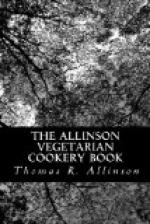No. II.—3 to 4 oz. of Allinson wholemeal or crushed wheat, coarse oatmeal or groats, hominy, maize or barley meal may be boiled for 1/2 an hour with milk and water, a very little salt being taken by those who use it. When ready, the porridge should be poured upon platters or soup-plates, allowed to cool, and then eaten with bread. Stewed fruits may be eaten with the porridge, or fresh fruit may be taken afterwards. When porridge is made with water, and then eaten with milk, too much fluid enters the stomach, digestion is delayed, and waterbrash frequently occurs. Meals absorb at least thrice their weight of water in cooking, so that 4 oz. of meal will make at least 16 oz. of porridge. Sugar, syrup, treacle, or molasses should not be eaten with porridge, as they are apt to cause acid risings in the mouth, heartburn, and flatulence. In summer, wholemeal and barleymeal make the best porridges, and they may be taken cold; in autumn, winter, and early spring, oatmeal or hominy are the best, and may be eaten lukewarm. When porridges are eaten, no other course should be taken afterwards, but the entire meal should be made of porridge, bread, and fruit. Neither cocoa nor any other fluids should be taken after a porridge meal, or the stomach becomes filled with too much liquid, and indigestion results. To make the best flavoured porridge, the coarse meal or crushed grain should be stewed in the oven for an hour or two; it may be made the day before it is required, and just warmed through before being brought to the table. This may be eaten with Allinson wholemeal bread and a small quantity of milk, or fresh or stewed fruit.
No. III.—Cut 4 to 6 oz. of Allinson wholemeal bread into dice, put into a basin, and pour over about 1/2 a pint of boiling milk, or milk and water; cover the basin with a plate, let it stand ten minutes, and then eat slowly. Sugar or salt should not be added to the bread and milk. An apple, pear, orange, grapes, banana, or other seasonable fruit may be eaten afterwards. No other foods should be eaten at this meal, but only the bread, milk, and fruit.
Labourers, artisans, and those engaged in hard physical work may take any of the above breakfasts. If they take No. I., they may allow themselves from 8 to 10 oz. of bread, and should drink a large cup of Brunak afterwards, as their work requires a fair amount of liquid to carry off some of the heat caused by the burning up of food whilst they are at work. If No. II. breakfast is taken, 6 to 8 oz. of meal may be allowed. If No. III. breakfast is eaten, then 6 or 8 oz. of bread and 2 pint of milk may be taken.
N.B.—Women require about a quarter less food than men do, and must arrange the quantity accordingly.
II.
MIDDAY MEALS.
The meal in the middle of the day must vary according to the work to be done after it. If much mental strain has to be borne or business done, the meal must be a light one, and should be lunch rather than dinner. Those engaged in hard physical work should make their chief meal about midday, and have a light repast in the evening.




